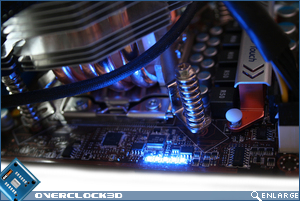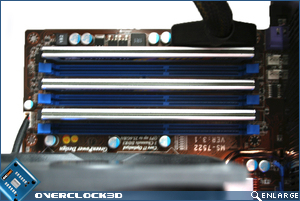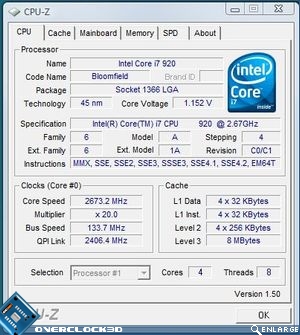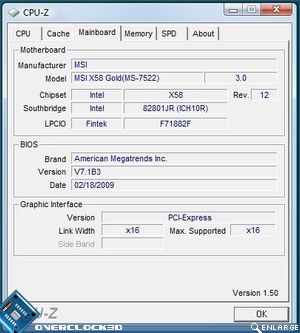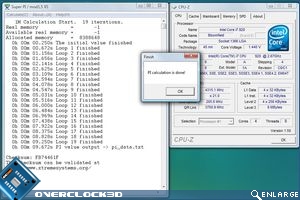MSI X58 Pro Motherboard
To ensure that all reviews on Overclock3D are fair, consistent and unbiased, a standard set of hardware and software is used whenever possible during the comparative testing of two or more products. The configuration used in this review can be seen below:Â
Motherboard: MSI X58 Pro
Memory: 6GB Corsair DDR3 @ 8-8-8-24 1600Mhz
Graphics Card: NVidia GTX280
Power Supply: Gigabyte Odin 1200W
CPU Cooling: Stock Intel Cooling
Hard Disk: Hitachi Deskstar 7K160 7200rpm 80GB
Graphics Drivers: Geforce 180.60 CUDA
Operating System: Microsoft Windows Vista Ultimate x64 SP1
During the testing of the setup above, special care was taken to ensure that the BIOS settings used matched whenever possible. A fresh install of Windows Vista was also used before the benchmarking began, with a full defrag of the hard drive once all the drivers and software were installed, preventing any possible performance issues due to leftover drivers from the previous motherboard installations. For the 3DMark and gaming tests a single card configuration was used.
Remember how earlier IÂ hinted at the multi GPU capabilities of the X58 Pro? Well the motherboard is capable of Crossfire as stock but NOT SLI. That is unless you fancy being a little naughty (as IÂ did) and flash the BIOS to the X58’s sister board, the X58 Pro SLI version. All that was required was for the BIOS file to be renamed, allowing the motherboard to detect the BIOS as compatible. Using MSI’s onboard M-Flash utility the BIOS flash went off without a hitch. IÂ shutdown, installed a 2nd GTX280 and voila!, the board recognised the 2nd GPU, installed the drivers automatically leaving me to enable SLIÂ via the Nvidia control panel. A quick run of 3DMark 06 verified that SLIÂ was indeed working with a good increase in performance and score.
Obviously, it should go without saying that you undertake this procedure at your own risk and neither MSI or Overclock3D will be held responsible for any bad flash as a result.
Â
To guarantee a broad range of results, the following benchmark utilities were used:
• Sisoft Sandra 2009
• PassMark CPU test
• SuperPI 1m, 8m, 32m
Memory Test
• Sisoft Sandra 2009
• Everest 4.60
File Compression & Encoding
• Sisoft Sandra 2009
• 7-Zip File Compression
• River Past ViMark
Disk I/O Performance
• HDTach 3.0.4.0
• Sisoft Sandra 2009
3D / Rendering Benchmarks
• Cinebench 10
• 3DMark 05
• 3DMark 06
• 3DMark Vantage
3D Games
• Crysis
• Far Cry 2
• Call of Duty 4
Overall System Performance
• PCMark Vantage
Power Consumption
Power consumption is an aspect often forgotten when it comes to enthusiast motherboards but in todays climate, with rising utility bills special consideration needs to be taken when choosing you components as over a period of time, one components can prove to be much more expensive than another over its lifetime.
Power consumption was measured at the socket using a plug-in mains power and energy monitor. Idle readings were taken after 5 minutes in Windows. Load readings were taken during a run of 3DMark Vantage.
Â
Here’s a couple of the obligatory CPU-Z screenshots at stock:
Â
Using a respectable Vcore of 1.40v set in the BIOS, the remainder of BIOS voltage settings were left in their stock state to ensure equality throughout the testing. Here’s what I managed out of the motherboard:
While I don’t profess a 1M SuperPI run to be evidence of stability (it plainly is not), at this speed it would be suicide to attempt a Prime run, as the CPU jumped straight to 90c after 10 seconds. Still, this is a fantastic result for MSI if somewhat very surprising. My only concern is the voltage fluctuation, if they can get that under control with future BIOS releases then they could well be on to a winner here.



